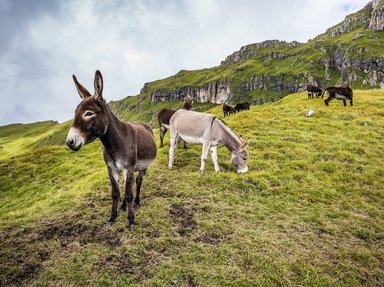Quiz Answer Key and Fun Facts
1. The correct term for Equus asinus, otherwise known as donkey or burro or jackstock
2. The correct term for a female donkey
3. A male donkey
4. Spanish loan-word synonymous with "donkey" but sometimes refers to smaller, working donkeys
5. The hybrid offspring of a male donkey and a female horse; the offspring may be either sex
6. The hybrid offspring of a male horse and a female donkey; the offspring may be either sex
7. A strictly male hybrid offspring of a male horse and female donkey
8. The female hybrid offspring of a male horse and a female donkey, especially if she might be able to reproduce
9. Bred from mares of riding-horse stock
10. Bred from mares of draft or work breeds
Source: Author
gracious1
This quiz was reviewed by FunTrivia editor
guitargoddess before going online.
Any errors found in FunTrivia content are routinely corrected through our feedback system.
